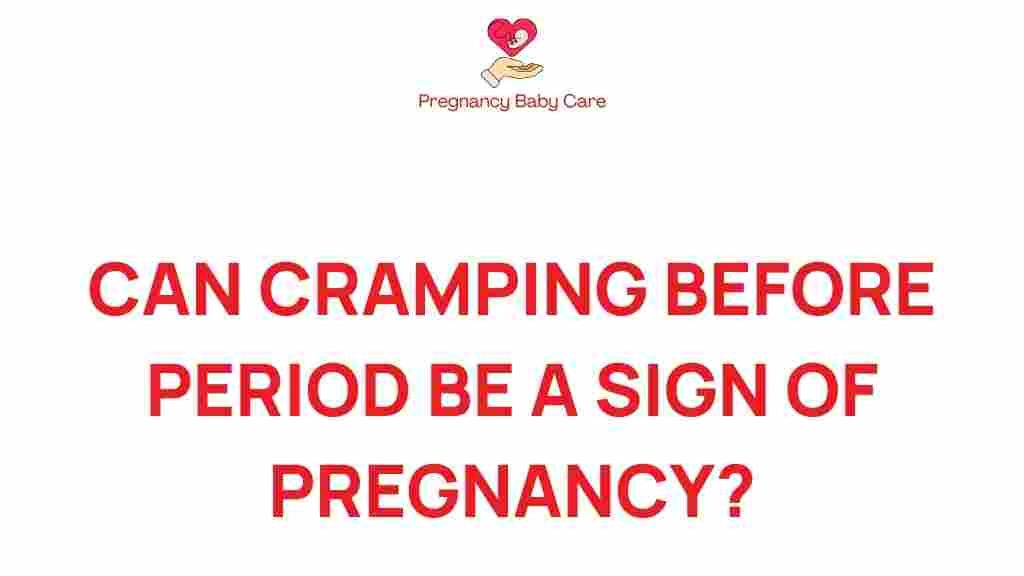Could Cramping Before Your Period Signal a Hidden Pregnancy?
Many women experience cramping before their period, but did you know that this sensation could also indicate a hidden pregnancy? Understanding the relationship between cramping, pregnancy, and your menstrual cycle is essential for reproductive health and women’s health overall. In this article, we will explore the early symptoms of pregnancy, the signs of pregnancy, and how cramping might fit into the bigger picture of ovulation and fertility.
Understanding Your Menstrual Cycle
The menstrual cycle is a complex interplay of hormones that prepares the body for potential pregnancy each month. It is typically divided into four phases: the menstrual phase, follicular phase, ovulation, and luteal phase. Here’s a brief overview:
- Menstrual Phase: This is when you have your period, and the lining of the uterus sheds.
- Follicular Phase: After menstruation, the body begins to prepare an egg for release.
- Ovulation: Around the midpoint of the cycle, an egg is released from the ovary.
- Luteal Phase: After ovulation, the body prepares for a possible pregnancy.
Cramping can occur at different times during this cycle, particularly during ovulation and just before your period. However, if you are experiencing cramping around the time your period is due, you might wonder if this could be a sign of pregnancy.
Cramping and Early Symptoms of Pregnancy
Many women report cramping as an early symptom of pregnancy. This is often due to implantation, which occurs when a fertilized egg attaches itself to the uterine lining, usually about 6 to 12 days after conception. The cramping associated with implantation can feel similar to menstrual cramps, making it difficult to distinguish between the two.
Signs of Pregnancy
Besides cramping, there are several other signs of pregnancy to be aware of:
- Missed Period: One of the most obvious signs, although some women may still experience light bleeding.
- Breast Changes: Tenderness, swelling, or darkening of the areolas can occur early in pregnancy.
- Fatigue: Increased levels of progesterone can lead to feelings of tiredness.
- Nausea: Often referred to as morning sickness, it can occur at any time of day.
- Frequent Urination: This may start early due to hormonal changes and increased blood flow to the kidneys.
If you are experiencing cramping along with these signs, it might be time to consider taking a pregnancy test.
When to Take a Pregnancy Test
Timing is crucial when it comes to taking a pregnancy test. Here is a step-by-step process to follow:
- Wait for Your Missed Period: Most tests are accurate if taken after you miss your period.
- Choose the Right Test: Look for a test that claims to detect early pregnancy.
- Follow Instructions: Read the instructions carefully to ensure accurate results.
- Check for Results: Wait the recommended time before reading the results.
For the most reliable information, consider consulting a healthcare professional if you suspect pregnancy.
Possible Causes of Cramping Before Your Period
While cramping can signify pregnancy, it can also be caused by various other factors, including:
- PMS (Premenstrual Syndrome): Many women experience cramping, mood swings, and other symptoms during PMS.
- Uterine Fibroids: These noncancerous growths can cause pain and discomfort.
- Endometriosis: A condition where tissue similar to the uterine lining grows outside the uterus, causing severe cramping.
- Pelvic Inflammatory Disease (PID): An infection of the reproductive organs that can lead to cramping and other symptoms.
If you notice unusual or severe cramping, it’s important to discuss these symptoms with your healthcare provider.
Cramping vs. Signs of Pregnancy: How to Differentiate
To better understand if cramping is a sign of pregnancy or just a part of your menstrual cycle, consider the following:
- Timing: If cramping occurs a week or two before your expected period, it could be PMS. If it happens closer to your missed period, it may indicate pregnancy.
- Intensity: Pregnancy-related cramping may be mild and fleeting, while menstrual cramps can be more intense.
- Accompanying Symptoms: Look for other signs of pregnancy such as nausea or breast tenderness.
Tips for Monitoring Your Reproductive Health
Maintaining awareness of your body can help you identify changes in your reproductive health. Here are some tips:
- Track Your Menstrual Cycle: Use apps or calendars to monitor your cycle and symptoms.
- Be Aware of Changes: Note any significant changes in your cycle, cramping, or other symptoms.
- Consult a Healthcare Provider: Regular check-ups can help you stay informed about your reproductive health.
For more information on reproductive health, check out this Women’s Health resource.
Conclusion
Cramping before your period can be a confusing experience, as it may signify either the onset of menstruation or a hidden pregnancy. By understanding your menstrual cycle and recognizing the early symptoms of pregnancy, you can make informed decisions regarding your reproductive health.
If you experience cramping that feels unusual or is accompanied by other concerning symptoms, don’t hesitate to consult with a healthcare professional. Staying proactive about your health is the best way to ensure your well-being.
In summary, while cramping can be a common part of the menstrual cycle, being vigilant about your body’s signals can help you navigate the complexities of fertility and pregnancy. Remember, knowledge is power when it comes to women’s health!
This article is in the category Pregnancy and created by PregnancyBabyCare Team
